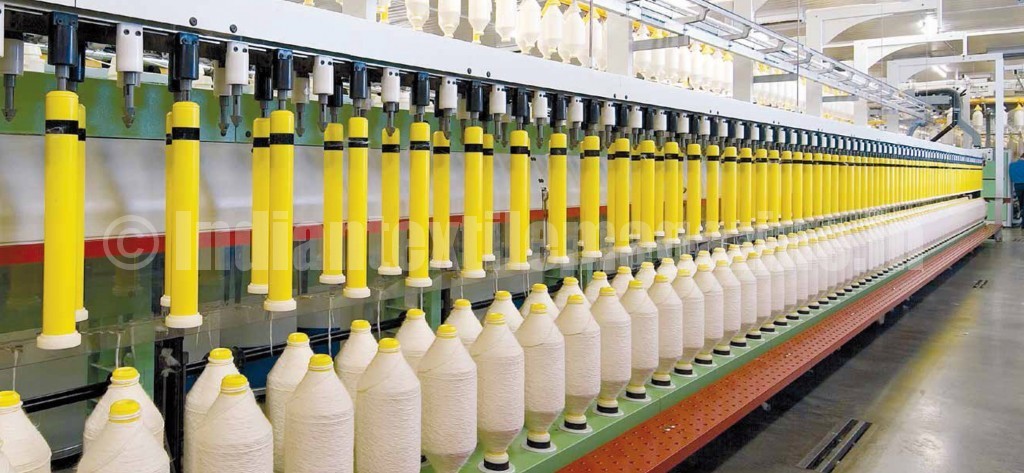
The roving frame which, unlike the carding machine, drawing frame or comber, is not directly responsible for the final quality, is one of the spinning line machines that are often unfairly overlooked. Actually, the quality of the spun yarn and the performance of the spinning machine also depend on the quality of frame bobbins. The bobbins should be compact and should be constantly taut over the whole formation without affecting the performance or output.
The Marzoli roving frame, made over 10 years ago, still remains an important machine on the global marketplace as it fully meets all these requirements and combines product quality with production capacity, reliability, efficiency and energy saving. The quality of the Marzoli frame starts with the sliver accompanying system on the feeding creel with hexagonal rollers. This is followed by the pneumatic arm and then gradually the flyers of the compressor and synchronisation of the movements.
With its new FT6 and FT7 models, the Marzoli electronic frame is making another step forward with regard to ease of use and reliability of the mechanical and electronic components. The company has always taken great care to reduce energy consumption of its roving frames.
With a view to green innovation, an important foundation for Marzoli design and manufacture, the new roving frame has been reconsidered both from mechanical and electrical/electronic points of view in order to further reduce energy consumption.
The new motors for the control of the 3kW spindles are highly efficient and are fixed directly on the rail. The motors control 32 spindles on the FT6 model and 24 on the FT7 model via timing belts. The new independent motorisation allowed the universal joint to be removed, thus simplifying the mechanical system and increasing the efficiency of the motor power transmission. This, together with the subsequent simplification of the head, reduction in maintenance and application of the latest edition Siemens Sinamics drive system, has resulted in a tangible reduction in power consumption. Now the power consumption for production of Ne 0.80 roving on a frame with 192 spindles is less than 0.080 kW/kg.
Moreover, by acquiring the special Energy Saving solution, power consumption on the roving frame can be further reduced by at least 3 kWh, thus reducing the overall production cost per kg of spun yarn produced.
This solution allows the suction system to be removed from the basic machine. The moving blower, along with the Marzoli R2S solution for monitoring breakage on the single roving, in combination with the use of individual cleaners, allows an adequate cleaning of the drafting area.
Furthermore, the flat surface beneath the roller system helps this stay clean. The power can consequently be reduced to 4kW because the suction motor is not used.
The R2S system designed and manufactured by Marzoli is simple, compact and easy to maintain. It allows breakage of a roving to be quickly detected and stops the machine to avoid dangerous winding. In combination with the new RTS Marzoli System, it allows the roving tension to be accurately checked during all stages of formation.
The precision in the rail movement control, the option of using different speed settings during the formation of the bobbin and the constantly monitored stability of the ratio between the speed of the spindles, flyers and roller system enables high quality bobbins to be formed with no variations in tension between the start and end of the bobbin.
The bobbin construction process can be entirely programmed via easy and intuitive display menus: FT6 gauge 220 mm from 32 to 192 spindle flyers 6×16”, FT7 gauge 260 mm from 48 to 144 spindle flyers 6×16” or 7×16”.
The Marzoli roving frame is the ideal solution when both manual and automatic doffing is required to transport bobbins to the spinning machines. During manual doffing, at the end of formation, the rail descends and is so positioned as to allow the operators easy access to remove the full bobbins and introduce empty tubes.
Automatic doffing occurs outside the machine and does not interfere with the operations of the personnel in any way. The machine stoppage time for doffing on a frame with 192 spindles is around three minutes. The standard machine has a 3-over-3 roller system with pneumatic arm and 32 mm bottom rollers. The 27mm rollers can be used for cotton with short fiber. With this solution the distance between the first and the second roller is reduced to only 45 mm, thus improving the control of the short fiber and consequently the quality of roving.
Another option is the four-roller system which can be obtained by adding a pair of rollers (bottom and top roller).